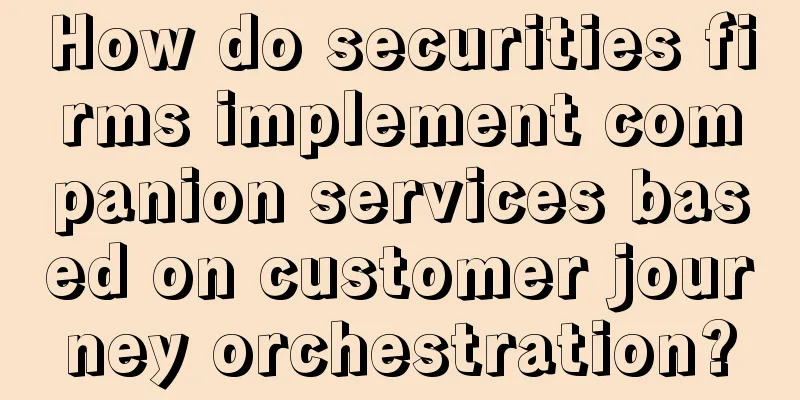How do securities firms implement companion services based on customer journey orchestration?

The essence of the financial industry is a service industry. At present, the channel services provided by traditional securities firms to customers are highly dependent on the licenses issued by the China Securities Regulatory Commission, and it is difficult to provide value to customers through differentiated services. With the high cost of attracting and opening accounts, the disappearance of traffic dividends, and the financial industry entering an era of stock competition, securities firms must move towards in-depth customer management through digital transformation and comprehensively improve the quality of wealth management transformation through end-to-end customer journey services. In this context, whether securities firms can provide accurate services to a large number of customers while deepening their relationship with valuable customers through companion services will become the key for enterprises to build differentiated competitiveness and achieve wealth management transformation in the digital age. 1. Three major difficulties faced in the implementation of companion servicesAfter the epidemic, the economy and investment have rebounded, and the demand for services from securities customers has increased significantly. Therefore, securities companies have focused their attention on this, and are committed to providing customers with differentiated, integrated solutions, platform-based services, and seamless delivery of accompanying service experiences, in order to increase customer retention and reduce customer complaints and churn rates to a greater extent. However, in the actual implementation process, there is insufficient online automation, insufficient offline specialization, insufficient service intelligence, lack of customer journey perspective in companion services, and lack of coherence in online and offline services, which has led to the following three major difficulties in the service implementation process: 1. Online and offline services are fragmented and fail to give full play to their own advantages, making it difficult to implement integrated collaborative servicesAt present, the business scenarios of securities companies cover online channels such as apps, WeChat public accounts, and WeChat mini-programs, as well as offline business outlets. However, online and offline have long been in a state of separation and independent operation, and only offline docking at the transaction data level has been achieved, failing to form an integrated system with strong timeliness and complementary advantages. For example, when securities firms conduct marketing activities for a certain product, the behavior records and process information of online users are often not transmitted to offline outlets in a timely manner, missing marketing opportunities and key service points. In addition, offline outlets only regard online channels such as apps, WeChat public accounts, and WeChat mini-programs as tools for completing transactions, lacking close cooperation, making it difficult to continuously improve the transmission effect. In addition, the end-to-end customer journey system in online scenarios lacks automation capabilities, resulting in offline investment advisors still having to spend a lot of time filling in basic service tasks and being unable to focus on in-depth customer management; offline investment advisory teams find it difficult to support the professional investment needs of valuable customers and establish long-term, lasting trust with customers; services lack a customer journey perspective, resulting in narrow end-to-end customer service coverage and difficulty in effective implementation. 2. Services lack intelligence and specialization, and the level of refinement of customer operations needs to be improvedThe sales of financial products are often more professional and complex, so it is necessary to interpret products, risks and expectations for customers. However, in the context of wealth management transformation, the personnel structure of each branch of securities companies has been updated and changed greatly, the service level and skills of employees are quite different, and the standardization and specialization of employee operation processes are low. However, the differentiated needs of various customer groups are becoming more and more distinct, requiring securities companies to upgrade from traditional customer stratification to refined customer group management. At the same time, branches and business outlets are limited by the resource endowments of their own regions, and it is difficult for them to form a good training promotion and employee empowerment system from a high-level perspective. They urgently need the headquarters to intensively and uniformly plan service processes, service resources and service skills, and form a set of continuous, stable and normalized solutions to comprehensively improve the professionalism of investment advisory services and build the brand influence of brokerage wealth management. In addition, in the past, there was often a mismatch between the services provided by brokerages and their customers. Account managers were often unable to provide appropriate services to customers in need in a timely manner, or they disturbed customers too much. The lack of a refined operating model led to an increasingly poor customer experience. 3. Operational management functions are dispersed and costly, making comprehensive business decision-making difficultDue to the different development paths and backgrounds of online and offline channels, the operation and management functions within securities companies are scattered in the operation projects of each channel itself, and some operation modules are bound to the purchased products, so the operation functions are relatively dispersed. At the same time, the function configuration of some operation modules is biased towards the technical perspective, the cost of use for business users is high, and they have not been well applied to actual business operations. The existing system foundation cannot support the operators to conceive of an integrated online and offline operation strategy with a "customer-centric" approach, nor can it complete operation statistics and overall effect tracking intuitively and conveniently. Technical personnel are overwhelmed by the frequent and changing data extraction needs of business operators. The overall business operation efficiency is difficult to improve, and comprehensive business decision-making is difficult. 2. Build a companion service system based on customer journey arrangementOverall, large-scale leading securities firms have a particularly strong demand for companion services: on the one hand, leading securities firms are more aware of the importance of companion services to their clients and themselves; on the other hand, the more leading securities firms are, the more sufficient capabilities and investment they have to build a companion service system and give full play to the value of companion services. In this regard, we believe that large-scale leading securities firms should fully understand their own customer base and strategic foundation, and through the deep integration of online marketing and offline services, form differentiated service models with different focuses to meet the needs of customers with different asset levels and investment preferences. Specifically, for high-net-worth clients, face-to-face services can be mainly provided by a mature offline advisory team; for wealth+ clients with certain investment experience such as urban white-collar workers and middle-class people, a service model combining online and offline services can be provided; for sensitive entry-level mass/long-tail customers, mainly online automated services can be provided. The customer-centric securities industry solution based on Customer Journey Orchestration (CJO) is as follows: Next, we will further understand it through two specific scenarios. Scenario 1: Fixed investment in fundsRegular investment in funds refers to an investment method in which customers invest a fixed amount of money in a fixed fund at every fixed time. It has a low participation threshold, convenient operation, and flexible investment. For customers, it can greatly disperse risks and meet the rigid needs of maintaining and increasing value. In this scenario, brokers can conduct refined customer operations from the perspective of CJO. When customers enter a key stage of their journey, they can proactively follow up and create a more comfortable experience for customers with companionship and warm services. Specifically, securities firms can first sort out the fund fixed investment process based on CJO: search/click on financial information → read articles/watch videos → query details (including performance trends, heavily weighted constituent stocks, subscription and redemption rules, etc.) → fund screening and horizontal comparison → subscription/subscription decision → long-term fixed investment, and then sort out the key steps of complete accompanying customer service based on the MTAOO methodology: 1. Map: Draw a detailed journey map of the customer's fund investment, as shown below: 2. Track: Sort out the key touchpoints of the fixed investment customer journey, access the tracking data of multiple scenarios such as App, mini-programs, official accounts, corporate WeChat, etc., and complete the data infrastructure construction. 3. Analyze: Conduct in-depth analysis based on the focus indicators at different stages of the customer journey, diagnose the consistency of the customer journey, and identify pain points and improvement points. 4. Orchestrate: Based on the journey pain points suggested by data analysis and the value analysis of different customer groups from a business perspective, reasonably orchestrate the customer journey and enhance customer experience and value through appropriate touchpoints, content, and timing. 5. Optimize: Pay attention to changes in key indicators and make flexible and dynamic adjustments to the journey orchestration method to better achieve customer journey traction. Scenario 2: Subscription of new sharesNew stock subscription is the purchase of newly issued stocks when a company issues stocks for the first time. Customers need to complete the subscription and can only officially purchase after winning the lottery. For securities firms, in the scenario of new stock subscription, it is necessary to provide complete accompanying services for customers who purchase new stocks, breaking the previous situation of mismatch between services and customers. On the one hand, they monitor stock fluctuations at all times and synchronize risks with customers to help customers make decisions in a timely manner and provide decision-making service support; on the other hand, based on customer journey orchestration, from the customer's "winning the lottery" to "exit", the interests of securities firms and customers are consistent, and they can provide customers with professional investment advice and service support to the greatest extent. For customers, the accompanying services provided by brokerages can help them obtain a consistent and coherent investment experience. Finally, let's summarize. There are qualitative differences between CJO and traditional corporate marketing: The marketing model of traditional financial institutions usually only focuses on business processes, starting from the internal perspective of the company, focusing on revenue, cost, efficiency, etc., and achieving a specific business goal and result through a series of organized tasks or activities. The enterprise digital customer management solution based on CJO breaks through traditional boundaries and pays more attention to the customer journey. It can help financial companies complete the visual management of the truly digital customer journey and provide customers with end-to-end personalized services more efficiently. At the same time, based on the rich touchpoints on the customer journey map, financial institutions can interact in real time to enhance customer value and optimize the operation plan at each touchpoint. In addition, through customer journey orchestration, financial institutions can easily identify the gap between existing processes and customer needs, bridge breakpoints, optimize card points, and comprehensively improve customer satisfaction and experience. Author: Sensors Data |
>>: It’s scary. Why do all the copywriting nowadays seem to be from the same mother?
Recommend
What are the common disputes in cross-border e-commerce? What are the skills to solve them?
When operating a store online, you will always enc...
How to advertise on Amazon variants? How to advertise?
Merchants who have opened stores on Amazon should ...
How to implement the no-source model in cross-border e-commerce? How to do cross-border e-commerce well?
With the continuous development of cross-border e-...
How can individual merchants start trading on Xiaohongshu at low cost? Attached is a low-cost strategy example
How can a business start an account on Xiaohongshu...
Has Xiaohongshu e-commerce found its way?
As we all know, Xiaohongshu has been committed to ...
The pre-sale of 618 is cancelled this year. Are the anchors worried?
During the 618 promotion in 2024, e-commerce platf...
Give your brand a “personality”
Brands are like people. Only people with personali...
Duoduo Short Video, returning to the original ecology of "moving content"?
Does Pinduoduo's move to the Duoduo Video page...
Black Myth: Wukong dominated the screen for a day
"Black Myth: Wukong" exploded the entire...
Can Xiaohong Bookstore’s live broadcast defeat the “saleswoman”?
This article mainly discusses Xiaohongshu’s new tr...
Can Shopee change its discounts? How to set prices correctly?
When opening a store on different e-commerce platf...
Yesterday, Station B decided to cancel the display of playback volume
Some time ago, the news that B station cancelled t...
How to optimize keywords on Amazon? What are the methods?
On Amazon, you can generally choose to use keyword...
What are the pros and cons of tradekey? What is the best thing to sell?
Nowadays, there are many people doing foreign trad...
“The No. 1 on TikTok” joins Pinduoduo?
Pinduoduo is going to take the track of live strea...









